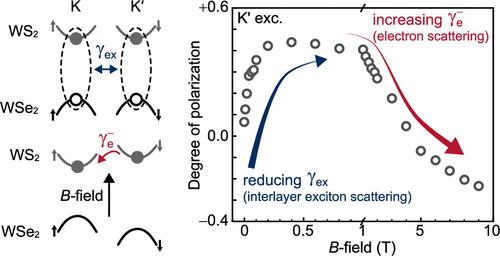Magneto-Polarization Controlled by Intervalley Scattering of Interlayer Excitons and Carriers in WS2/WSe2 Heterostructure
IF 9.1
1区 材料科学
Q1 CHEMISTRY, MULTIDISCIPLINARY
引用次数: 0
Abstract
The photoluminescence polarization of interlayer excitons (IXs) offers a powerful tool for exploring moiré physics of transition metal dichalcogenide (TMD) heterostructures. However, in WS2/WSe2 heterostructures, this polarization is often weak and the underlying mechanism of intervalley scattering remains unclear. Notably, the closeness of IX lifetime and carrier valley lifetime complicates the investigation of the scattering process. Here, we demonstrate that magnetic fields can sensitively tune the polarization and valley dynamics of both IX and carriers in WS2/WSe2 heterostructures. We find that small magnetic fields can suppress IX intervalley scattering, significantly enhancing valley polarization, whereas at higher magnetic fields, IX emission is largely controlled by the intervalley scattering of electrons, leading to excitation-dependent polarization and saturation effects. Our results highlight the interplay between carrier dynamics and exciton valley behaviors in tailoring IX photoluminescence and offering potential pathways for the design of valleytronic devices leveraging TMD heterostructures.

WS2/WSe2异质结构中层间激子和载流子的谷间散射控制磁极化
层间激子(IXs)的光致发光偏振为探索过渡金属二卤化物(TMD)异质结构的摩尔纹物理提供了有力的工具。然而,在 WS2/WSe2 异质结构中,这种极化通常很弱,而且层间散射的基本机制仍不清楚。值得注意的是,IX 寿命和载流子谷寿命的接近使散射过程的研究变得复杂。在这里,我们证明了磁场可以灵敏地调节 WS2/WSe2 异质结构中 IX 和载流子的极化和谷动态。我们发现,小磁场可抑制 IX 间隙散射,显著增强谷极化,而在较高磁场下,IX 发射主要受电子间隙散射控制,从而产生依赖于激发的极化和饱和效应。我们的研究结果突显了载流子动力学和激子谷行为在定制 IX 光致发光中的相互作用,并为利用 TMD 异质结构设计谷电子器件提供了潜在的途径。
本文章由计算机程序翻译,如有差异,请以英文原文为准。
求助全文
约1分钟内获得全文
求助全文
来源期刊

Nano Letters
工程技术-材料科学:综合
CiteScore
16.80
自引率
2.80%
发文量
1182
审稿时长
1.4 months
期刊介绍:
Nano Letters serves as a dynamic platform for promptly disseminating original results in fundamental, applied, and emerging research across all facets of nanoscience and nanotechnology. A pivotal criterion for inclusion within Nano Letters is the convergence of at least two different areas or disciplines, ensuring a rich interdisciplinary scope. The journal is dedicated to fostering exploration in diverse areas, including:
- Experimental and theoretical findings on physical, chemical, and biological phenomena at the nanoscale
- Synthesis, characterization, and processing of organic, inorganic, polymer, and hybrid nanomaterials through physical, chemical, and biological methodologies
- Modeling and simulation of synthetic, assembly, and interaction processes
- Realization of integrated nanostructures and nano-engineered devices exhibiting advanced performance
- Applications of nanoscale materials in living and environmental systems
Nano Letters is committed to advancing and showcasing groundbreaking research that intersects various domains, fostering innovation and collaboration in the ever-evolving field of nanoscience and nanotechnology.
 求助内容:
求助内容: 应助结果提醒方式:
应助结果提醒方式:


